
Ely is a city in Saint Louis County, Minnesota, United States. The population was 3,268 at the 2020 census.

The Mesabi Iron Range is a mining district and mountain range in northeastern Minnesota following an elongate trend containing large deposits of iron ore. It is the largest of four major iron ranges in the region collectively known as the Iron Range of Minnesota. First described in 1866, it is the chief iron ore mining district in the United States. The district is located largely in Itasca and Saint Louis counties. It has been extensively worked since 1892, and has seen a transition from high-grade direct shipping ores through gravity concentrates to the current industry exclusively producing iron ore (taconite) pellets. Production has been dominantly controlled by vertically integrated steelmakers since 1901, and therefore is dictated largely by US ironmaking capacity and demand.

The Iron Range is collectively or individually a number of elongated iron-ore mining districts around Lake Superior in the United States and Canada. Much of the ore-bearing region lies alongside the range of granite hills formed by the Giants Range batholith. These cherty iron ore deposits are Precambrian in the Vermilion Range and middle Precambrian in the Mesabi and Cuyuna ranges, all in Minnesota. The Gogebic Range in Wisconsin and the Marquette Iron Range and Menominee Range in Michigan have similar characteristics and are of similar age. Natural ores and concentrates were produced from 1848 until the mid-1950s, when taconites and jaspers were concentrated and pelletized, and started to become the major source of iron production.
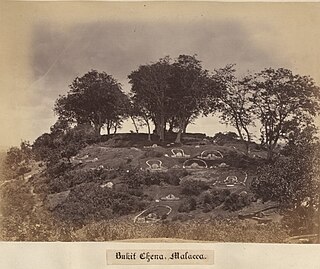
Bukit China is a hillside of historical significance in Malacca City, the capital of the Malaysian state of Malacca. It is located several kilometres to the north from the historical centre of Malacca. The site is today surrounded by the modern city on all sides.

Dungun is a coastal district of the Malaysian state of Terengganu. Kuala Dungun is the capital of the district. Dungun is made up of eleven 'mukim', or subdistricts: Abang, Besol, Jengai, Jerangau, Kuala Dungun, Kuala Paka, Kumpal, Pasir Raja, Rasau, Sura, and Hulu Paka.

Fraser's Hill is a hill resort located on the Titiwangsa Ridge in Raub District, Pahang, Malaysia. It is about 100 km (62 mi) north of Kuala Lumpur. In 1890, Louis James Fraser established the area as a tin mining community known as Pamah Lebar when he discovered rich tin deposits and opened a tin mining facility. Mining activity there was short-lived, as the tin ore was depleted in 1913. This led many miners and farmers to abandon the area. Fraser reportedly disappeared in 1910, but research in 2019 concluded that he retired from his position and returned to Great Britain in 1910. He died in 1916 while travelling in Austria-Hungary.

Taiping is a town located in Larut, Matang and Selama District, Perak, Malaysia. It is located approximately 48 km (30 mi) northwest of Ipoh, the capital of Perak, and 78 km (48 mi) southeast of George Town, Penang. With a population of 245,182, it is the second largest town in Perak after Ipoh, the state capital.
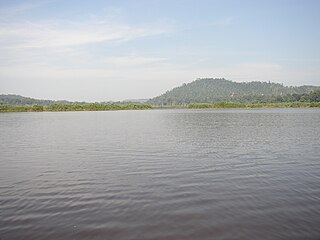
Chini Lake is a lake in Pekan District, Pahang, Malaysia. The lake shores are inhabited by the Jakun branch of the Orang Asli, indigenous ethnic groups of Malysia.
Raub is a town in Raub District, Pahang, Malaysia. Raub is one of the oldest towns in Pahang.

Bukit Larut is a hill resort in Malaysia located in the state of Perak, Malaysia, 10 kilometres southwest from Taiping. It was established under the direction of British colonists in 1884 as a place of observation for tin mining activity and as a retreat for the English people who were based in nearby Larut and Taiping. The area was initially named Maxwell Hill after the British Malaya administrator George Maxwell, and was renamed as Bukit Larut in 1979.
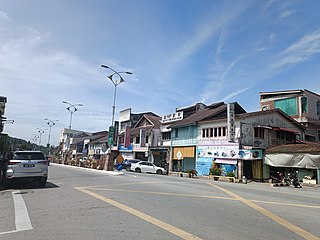
Lenggong is a town, a mukim and a parliamentary constituency in Hulu Perak District, Perak, Malaysia.
Bandar Muadzam Shah is a sub-district in Rompin District, Pahang, Malaysia. The town was established in 1979 by the South-East Pahang Development Authority (DARA) under the purview of the second Malaysian Prime Minister, Tun Abdul Razak, who also happened to be the native of nearby royal town of Pekan.
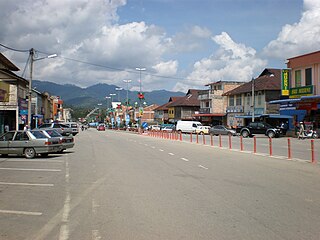
Pengkalan Hulu, formerly known as Kroh or Keroh, is a town and a mukim in Hulu Perak District, Perak, Malaysia, bordering Thailand and Kedah. The nearest town on the Thailand side is Betong in Yala province.

Bukit Kangkar is a small town in Mukim Serom, Tangkak District, Johor, Malaysia. The town is approximately 16 km from Muar and 12 km from Tangkak. The town is centered on villages and modern housing areas. The 2 main villages are Kampung Parit Pelampong and Kampung Gelugur.
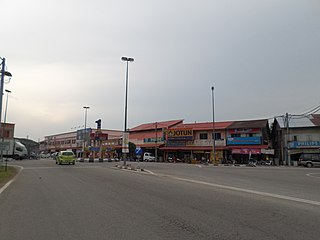
Selandar is a mukim and town in Jasin District, Malacca, Malaysia.
Federal Route 63 is a federal road in Pahang, Malaysia, linking the town of Bukit Ibam and Bandar Muadzam Shah to the town of Bandar Baru Rompin. The road was built at the site of a defunct light railway track from Bukit Ibam to Kuala Rompin.

The Gogebic Range is an elongated area of iron ore deposits located within a range of hills in northern Michigan and Wisconsin just south of Lake Superior. It extends from Lake Namakagon in Wisconsin eastward to Lake Gogebic in Michigan, or almost 80 miles. Though long, it is only about a half mile wide and forms a crescent concave to the southeast. The Gogebic Range includes the communities of Ironwood in Michigan, plus Mellen and Hurley in Wisconsin.

The Taiping Lake Gardens is the first public garden established during the British rule in Malaysia. The garden is located near Bukit Larut, and is equidistant to the town centre and the Taiping Zoo.

Mining is one of the main industries in Malaysia. Malaysia produces aggregate, bauxite, clay, coal, copper, feldspar, gold, gravel, ilmenite, iron ore, kaolin, limestone, mica, monazite, sand, silica sand, struverite and tin.
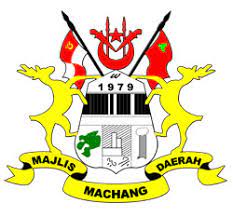
Machang is a town in Machang District, Kelantan, Malaysia. It is a home to one of the main campuses of Universiti Teknologi MARA.














